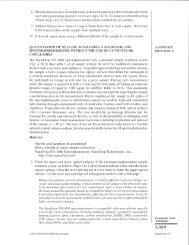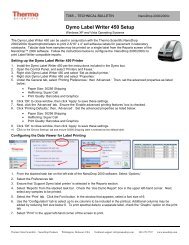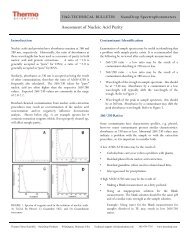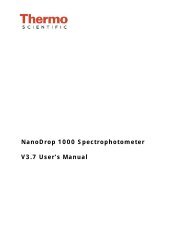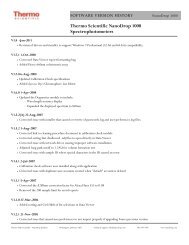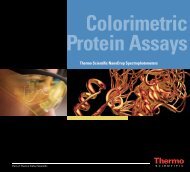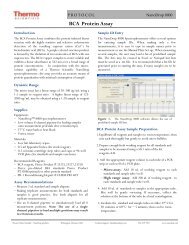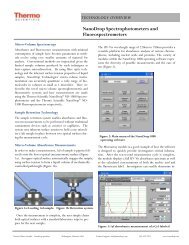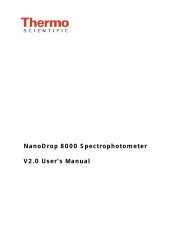Download this publication as PDF - NanoDrop
Download this publication as PDF - NanoDrop
Download this publication as PDF - NanoDrop
You also want an ePaper? Increase the reach of your titles
YUMPU automatically turns print PDFs into web optimized ePapers that Google loves.
Nucleic AcidThe information in <strong>this</strong> <strong>publication</strong> is provided for reference only. All information contained in <strong>this</strong> <strong>publication</strong> is believed to be correct andcomplete. Thermo Fisher Scientific shall not be liable for errors contained herein nor for incidental or consequential damages in connectionwith the furnishing, performance or use of <strong>this</strong> material. All product specifications, <strong>as</strong> well <strong>as</strong> the information contained in <strong>this</strong> <strong>publication</strong>, aresubject to change without notice.This <strong>publication</strong> may contain or reference information and products protected by copyrights or patents and does not convey any license under our patentrights, nor the rights of others. We do not <strong>as</strong>sume any liability arising out of any infringements of patents or other rights of third parties.We make no warranty of any kind with regard to <strong>this</strong> material, including but not limited to the implied warranties of merchantability and fitness for aparticular purpose. Customers are ultimately responsible for validation of their systems.© 2010 Thermo Fisher Scientific Inc. All rights reserved. All trademarks are the property of Thermo Fisher Scientific Inc. and its subsidiaries.Copyrights in and to the technical support image are owned by a third party and licensed for limited use only to Thermo Fisher Scientific byiStockphoto. No part of <strong>this</strong> <strong>publication</strong> may be stored in a retrieval system, transmitted, or reproduced in any way, including but not limited to photocopy,photograph, magnetic or other record, without our prior written permission.Microsoft, Windows, Windows NT and Excel are either trademarks or registered trademarks of Microsoft Corporation in the United States and/orother countries.Adobe and Acrobat are trademarks of Adobe Systems, Incorporated. All other trademarks are the property of Thermo Fisher Scientific Inc. and itssubsidiaries.<strong>NanoDrop</strong> is a trademark of Thermo Fisher Scientific. Revised 11/2010
Thermo Scientific <strong>NanoDrop</strong> SpectrophotometersNucleic AcidContentsIntroduction 4Sample Retention Technology 5Best Practices 6Cleaning & Reconditioning 6Instrument & Cuvette Orientation 7Sampling Technique 8Sample Purification 9Me<strong>as</strong>urements 10Blank Me<strong>as</strong>urements 10Sample Me<strong>as</strong>urements 10Concentration Calculations 12Modified Beer-Lambert Equation 12Pathlength & Concentration 13Purity Ratios 14Calibration 15Calibration Verification 15Standard vs Control 16Troubleshooting 17Purity Ratios 17Common Reagents 18Unusual Spectra 19Reproducibility 20Instrument Related Issues 21Installation Errors 22Connection Errors 23Signal Errors 23FAQs 24Technical Support 27
Thermo Scientific <strong>NanoDrop</strong> SpectrophotometersNucleic AcidIntroductionThis booklet provides nucleic acid me<strong>as</strong>urement support information relevant to Thermo Scientific<strong>NanoDrop</strong> 2000/2000c, 8000 and 1000 spectrophotometers. Ple<strong>as</strong>e refer to the model-specific usermanual for more detailed instrument and software feature-related information.The patented <strong>NanoDrop</strong> sample retention system employs surface tension to hold 0.5 μL to 2 μLsamples in place between two optical fibers.Separate booklets for direct A280 protein me<strong>as</strong>urement and colorimetric methods arealso available.For technical support, ple<strong>as</strong>e contact:Thermo Fisher Scientific | <strong>NanoDrop</strong> Products3411 Silverside Road | Bancroft Building | Wilmington, DE 19810 USAToll-free in US and Canada: 1.877.724.7690Phone: 1.302.479.7707 | Fax: 1.302.792.7155 | e-mail: nanodrop@thermofisher.comwww.nanodrop.comThermo Scientific <strong>NanoDrop</strong> Instrument Serial Numbers:<strong>NanoDrop</strong> 1000: S/N_ ________, S/N_ ________<strong>NanoDrop</strong> 2000: S/N_ ________, S/N_ ________<strong>NanoDrop</strong> 2000c: S/N_ ________, S/N_ ________<strong>NanoDrop</strong> 8000: S/N_ ________, S/N_ ________4
Thermo Scientific <strong>NanoDrop</strong> SpectrophotometersNucleic AcidIntroductionSample RetentionTechnologyIntroduction• Pipette 1 – 2 μL sample directly onto the me<strong>as</strong>urement pedestal.Tip: 0.5 μL aliquots may be used for samples that have 10 mm equivalent absorbance valuesof 3.0 or higher ( >150 ng/ μL dsDNA). <strong>NanoDrop</strong> 2000/2000c model only.• Lower the sampling arm and initiate a spectral me<strong>as</strong>urement using the software on the PC.• Surface tension is used to hold samples in place between two optical fibers.• Light from a xenon fl<strong>as</strong>hlamp p<strong>as</strong>ses through the top optical fiber, down through the liquidcolumn and is detected by the internal spectrometer.• When the me<strong>as</strong>urement is complete, raise the sampling arm and wipe the sample from boththe upper and lower pedestals using a dry, lint-free laboratory wipe.Using <strong>this</strong> technology, <strong>NanoDrop</strong> spectrophotometers have the capability to me<strong>as</strong>ure samplesbetween 50 and 200 times more concentrated than samples me<strong>as</strong>ured using a standard1 cm cuvette.5
Thermo Scientific <strong>NanoDrop</strong> SpectrophotometersNucleic AcidBest PracticesCleaning• An initial cleaning of both me<strong>as</strong>urement surfaces with dH 2O is recommended prior to makingthe blank me<strong>as</strong>urement. Do NOT use a squirt or spray bottle to apply water or any other liquidto the surface of the instrument.• Between me<strong>as</strong>urements: Wipe the sample from both the upper and lower pedestals with aclean, dry, lint-free lab wipe.• A final cleaning of both me<strong>as</strong>urement surfaces with dH 2O is recommended after the l<strong>as</strong>tsample me<strong>as</strong>urement. Do NOT use a squirt or spray bottle to apply water or any other liquid tothe surface of the instrument.• Additional cleaning: Use 3 µL of HCl instead of the dH 2O for cleaning when samples havedried on the pedestal. Follow with a 3 µL aliquot of dH 2O.• Detergents and isopropyl alcohol are NOT recommended cleaning agents <strong>as</strong> they mayuncondition the pedestal me<strong>as</strong>urement surfaces. If a solution containing detergents oralcohol is used, follow with 3 – 5 µL of dH 2O.ReconditioningUse the <strong>NanoDrop</strong> Pedestal Reconditioning Compound (PR-1) <strong>as</strong> a rapid means of reconditioningthe pedestals when the hydrophobic surface properties have been compromised and liquidcolumns break during me<strong>as</strong>urement.1. Open the vial containing PR-1 and use the applicator provided in the kit to remove apin-head sized amount of the compound.2. Apply a very thin, even layer of PR-1 to the flat surface of the upper and lower pedestals.Wait 30 seconds for the PR-1 to dry.3. Fold a clean, dry laboratory wipe into quarters and remove the PR-1 by rubbing the surface of theupper and lower pedestals until no additional dark compound residue shows on the lab wipe.Pedestal AssessmentTo check the effectiveness of the reconditioning,pipet a 1 μL aliquot of dH 2O onto the lowerme<strong>as</strong>urement pedestal and visually verify thatthe water “beads up.”Droplet “flattens out” onunconditioned pedestalDroplet “beads up” onproperly conditioned pedestal6
Thermo Scientific <strong>NanoDrop</strong> SpectrophotometersNucleic AcidBest PracticesInstrument OrientationAngle the instrument for optimal pipetting.Right-handed orientation for the <strong>NanoDrop</strong> 2000/2000c and close-up view of the <strong>NanoDrop</strong> 8000.Below, recommended orientation for left- and right-handed sample dispensing on the <strong>NanoDrop</strong> 8000.Best PracticesCuvette Orientation(<strong>NanoDrop</strong> 2000c only)Use etched arrow <strong>as</strong> light path guide when inserting quartz or m<strong>as</strong>ked pl<strong>as</strong>tic cuvette.Tip: Locate instrument away from air currents and exhaust fans.7
Thermo Scientific <strong>NanoDrop</strong> SpectrophotometersNucleic AcidBest PracticesSampling TechniqueVolume RequirementUse adequate sample volume to ensure good column formation.Tip: Although 1 μL volumes are usually sufficient for most sampleme<strong>as</strong>urements, incre<strong>as</strong>ing the sample size to 2 μL will ensure propercolumn formation for samples with reduced surface tension.Pipettor SelectionUse calibrated pipettor with well-fitting tips.It is best to use a precision pipettor (0 – 2 μL) with low retention,precision tips to ensure that sufficient sample (1 – 2 μL) is delivered foroptimal column formation.Tip: To avoid evaporation errors, it is essential to use an eight-channelpipettor to simultaneouslyload samples when using two or morepedestal positions on the <strong>NanoDrop</strong> 8000.Sample AliquotsAlways use fresh tips and fresh aliquots for every me<strong>as</strong>urement.Tip: Repeated me<strong>as</strong>urements on the same sample aliquot will result inevaporation, yielding incre<strong>as</strong>ing concentrations and/or column breakage.Sample HomogeneityHighly concentrated nucleic acid samples require careful attention toensure homogeneity before sampling.Tip: Non-reproducible results observed when making small volumeme<strong>as</strong>urements are a good indicator that the sample is not fully in solutionor is not homogenous.Tip: It may be necessary to heat and/or lightly vortex samples prior tosampling to ensure homogeneity.Sample PreparationEnsure sample isolation procedure is optimized and sample is purifiedprior to me<strong>as</strong>urement.8
Thermo Scientific <strong>NanoDrop</strong> SpectrophotometersNucleic AcidBest PracticesSample PurificationAny molecule that absorbs at 260 nm will contribute to the totalabsorbance value used to calculate sample concentrations. Examplesinclude DNA, RNA, free nucleotides, proteins and some dyes, <strong>as</strong> well <strong>as</strong>many other molecules found in common buffers.Tip: To minimize the potential of overestimating a nucleic acid sampleconcentration <strong>as</strong> a result of an interfering substance, it is important topurify samples prior to making absorbance me<strong>as</strong>urements.Lab Notes9
Thermo Scientific <strong>NanoDrop</strong> SpectrophotometersNucleic AcidMe<strong>as</strong>urementsBlank Me<strong>as</strong>urements1. Perform the Cleaning and Reconditioning procedures outlined in the Best Practicessectionon page 6.2. Open the Nucleic Acid application. Load an aliquot of the blanking buffer onto the lowerme<strong>as</strong>urement pedestal and lower the sampling arm.Tip: The blank solution should be the same pH and of a similar ionic strength <strong>as</strong> the samplesolution. For nucleic acid samples, blank buffers are generally dH 2O or TE. Blanking with waterfor samples dissolved in TE may result in low 260/230 ratios.3. Click Blank to me<strong>as</strong>ure and store the reference spectrum. After the me<strong>as</strong>urement iscomplete, use a dry, lint-free lab wipe to remove the buffer from both the top and bottomme<strong>as</strong>urement surfaces.4. Pipette a fresh aliquot of the buffer onto the pedestal, lower the arm and click Me<strong>as</strong>ure. Theresult should be a spectrum that varies no more than 0.04 Abs (10 mm absorbance equivalent)from the b<strong>as</strong>eline at 260 nm. If not, clean the me<strong>as</strong>urement surfaces and repeat steps 2 and 3.Tip: Although it is not necessary to blank between each sample, it is recommended that a newblank be taken every 30 minutes when me<strong>as</strong>uring many samples.Sample Me<strong>as</strong>urements1. After the blank me<strong>as</strong>urement is complete, enter the sample name in the Sample ID box, andchoose the appropriate sample type <strong>as</strong> described below:Constant UsedSample Type Select Option to Calculate Applicable ModelsConcentrationdsDNA DNA-50 50 AllssDNA DNA-33 33 AllRNA RNA-40 40 AllOligo Oligo DNA or Oligo Calulator Defined <strong>NanoDrop</strong> 2000/2000c andOligo RNA <strong>NanoDrop</strong> 8000Oligo Custom 15 – 150* <strong>NanoDrop</strong> 2000/2000cOligo Other 15 – 150* <strong>NanoDrop</strong> 8000 and<strong>NanoDrop</strong> 1000*Range for user-entered constant.10
Thermo Scientific <strong>NanoDrop</strong> SpectrophotometersNucleic AcidMe<strong>as</strong>urementsSample Me<strong>as</strong>urements2. Pipette an aliquot of the nucleic acid sample onto the lower me<strong>as</strong>urement pedestal and lowerthe sampling arm. Click Me<strong>as</strong>ure.Tip: If me<strong>as</strong>uring more than one sample at a time on the <strong>NanoDrop</strong> 8000, it is important to use amulti-channel pipettor to deliver the sample aliquots.3. After the me<strong>as</strong>urement is complete, use a dry, lint-free lab wipe to remove the sample fromboth the top and bottom me<strong>as</strong>urement surfaces.4. Change pipette tips for the next me<strong>as</strong>urement.Tip: If me<strong>as</strong>uring multiple replicates of the same sample, it is important to use a fresh aliquotfor every me<strong>as</strong>urement to ensure accurate results.5. Review spectral image to <strong>as</strong>sess sample quality.10mm Absorbance38 -36 -260nm34 -32 -30 -28 -26 -24 -22 -20 -18 -280nm16 -230nm14 -12 -10 -8 -6 -4 -2 -0 -220 230 240 250 260 270 280 290 300 310 320 330 340Wavelength nmMe<strong>as</strong>urementsTypical Nucleic Acid SpectrumRefer to the Purity RatiosandTroubleshootingsections on pages 14 and 17 for more information.11
Thermo Scientific <strong>NanoDrop</strong> SpectrophotometersNucleic AcidConcentration CalculationsModified Beer-LambertEquationFor nucleic acid quantification, amodification of the Beer-Lambert equation isused to calculate sample concentrations.c = (A * e)/b• c is the nucleic acid concentration in ng/μL• A is the absorbance in AU• eis the wavelength-dependent extinctioncoefficient in ng-cm/μL• b is the pathlength in cmNucleic acid sample concentrations are b<strong>as</strong>edon the absorbance at 260 nm, the selectedanalysis constant and a b<strong>as</strong>eline correction.• The correction normalizes for any b<strong>as</strong>elineoffset attributable to light scattering artifacts.• The wavelength for the b<strong>as</strong>elinenormalization is 340 nm.Tip: The user may manually enter a differentwavelength to be used for the b<strong>as</strong>elinenormalization of nucleic acid samples whenusing the <strong>NanoDrop</strong> 2000/2000c.The generally accepted extinctioncoefficients or constants for nucleic acidsare <strong>as</strong> indicated to the right:• Double-stranded DNA: 50 ng-cm/μL• Single-stranded DNA: 33 ng-cm/μL• RNA: 40 ng-cm/μLConcentrations determined by absorbanceme<strong>as</strong>urements with <strong>NanoDrop</strong>spectrophotometers are reported interms of m<strong>as</strong>s units (i.e., ng/μL).Tip: Unit conversion calculators areavailable on the internet for the conversionof concentrations from m<strong>as</strong>s to molar unitsb<strong>as</strong>ed upon the specific sequence ofthe sample.12
Thermo Scientific <strong>NanoDrop</strong> SpectrophotometersNucleic AcidConcentration CalculationsPathlength &Concentration<strong>NanoDrop</strong> instrument pedestal me<strong>as</strong>urements utilize pathlengths of 1.0 mm to 0.05 mm (modeldependent). The pathlengths are the distance between the optical fibers embedded in theupper and lower me<strong>as</strong>urement surfaces. As described in the previous section, the pathleng<strong>this</strong> one component of Beer’s Law and must be taken into account when calculating sampleconcentrations using absorbance me<strong>as</strong>urements.As the pathlength gets shorter, the ability to me<strong>as</strong>ure higher concentrations without saturatingthe internal detector incre<strong>as</strong>es. Although the upper detection limit of the internalspectrometer is ~ 1.5 Absorbance units, the <strong>NanoDrop</strong> sample retention technologyallows for the use of shorter pathlengths, thereby extending the absorbance rangeof the instrument.The graphic below illustrates how utilizing pathlengths less than the standard 10 mm cuvette pathlengthenables higher concentrations of samples to be me<strong>as</strong>ured without making sample dilutions.10 mm pathlengthmax concentration= 75 ng/µL dsDNA10 mm pathlengthmax Abs value = 1.51 mm pathlengthmax concentration= 750 ng/µL dsDNAEquivalent to max Abs valueof 15 when normalized to a10 mm pathlength0.2 mm pathlengthmax concentration= 3,750 ng/µL dsDNAEquivalent to max Abs valueof 75 when normalized to a10 mm pathlengthModelDetection Limits for dsDNA<strong>NanoDrop</strong> 20002 to 15,000 ng/μL<strong>NanoDrop</strong> 2000c0.4* to 15,000 ng/μL<strong>NanoDrop</strong> 80002.5 to 3750 ng/μL<strong>NanoDrop</strong> 10002 to 3750 ng/μL* Denotes lower detection limit when using 10 mm path cuvette.ConcentrationCalculations13
Thermo Scientific <strong>NanoDrop</strong> SpectrophotometersNucleic AcidPurity RatiosAlthough purity ratios are important indicators of sample quality, the best indicator of DNA or RNAquality is functionality in the downstream application of interest (e.g., real-time PCR).260/280 Ratio • A 260/280 ratio of ~ 1.8 is generally accepted <strong>as</strong> “pure” for DNA.• A 260/280 ratio of ~ 2.0 is generally accepted <strong>as</strong> “pure” for RNA.• The reported 260/280 ratio is dependent on the pH and ionic strengthof the buffer used to make the blank me<strong>as</strong>urement and sampleme<strong>as</strong>urements. Acidic solutions will under-represent the 260/280ratio by 0.2 – 0.3, while a b<strong>as</strong>ic solution will over-represent the ratioby 0.2 – 0.3**.** William W. Wilfinger, Karol Mackey, and Piotr Chomczynski, Effect of pH andIonic Strength on the Spectrophotometric Assessment of Nucleic Acid Purity:BioTechniques 22:474-481 (March 1997)Tip: If the ratio is appreciably different than the accepted targetdescribed above, it may indicate the presence of protein, phenolor other contaminants that absorb strongly at or near 260 nm.Tip: It is important to ensure that the blank and sample buffers are atthe same pH and ionic strength.260/230 Ratio • The 260/230 values for a “pure” nucleic acid are often higher thanthe respective 260/280 values and are commonly in the range of1.8 – 2.2.Tip: If the ratio is appreciably different than the accepted target, itmay indicate the presence of residual phenol, guanidine, magneticbeads, carbohydrates or proteins.Tip: It is important to ensure that the blank and sample buffers are atthe same pH and ionic strength. A low 260/230 ratio may indicate anissue with the buffer used for the blank me<strong>as</strong>urement. Refer to theTroubleshootingsection on page 17 for more information.14
Thermo Scientific <strong>NanoDrop</strong> SpectrophotometersNucleic AcidCalibrationCalibration VerificationAll <strong>NanoDrop</strong> spectrophotometers include a diagnostic application which allows the user to runa Calibration Check procedure to confirm that the instrument is working within specifications.Wavelength Calibration(Automatic)Pathlength Verification(User-performed)• Wavelength calibrations using standard reference lines in thexenon fl<strong>as</strong>hlamp spectrum are automatically performed within theoperating software.• This verification ensures wavelength accuracy and does notrequire any action by the user.• Use CF-1 in conjunction with the Calibration Check diagnosticto verify that the pathlengths are within specification.• The pathlengths used to make me<strong>as</strong>urements are the sameacross all wavelengths. Therefore, when pathlengths are verifiedat one wavelength, the verification is valid for the entireme<strong>as</strong>ured spectrum.Purity Ratios Calibration VerificationCalibration Check Fluid• CF-1 is a standard manufactured exclusively for use with<strong>NanoDrop</strong> Spectrophotometers and is available fromThermo Fisher Scientific and its distributors.• The CF-8 Calibration Kit (used for the <strong>NanoDrop</strong> 8000 calibrationcheck procedure) includes 2 CF-1 vials <strong>as</strong> well <strong>as</strong> 8-well PCRstrip tubes.Tip: It is good practice to check the instrument’s performanceevery six months with a new vial of <strong>NanoDrop</strong> CalibrationCheck Fluid.15
Thermo Scientific <strong>NanoDrop</strong> SpectrophotometersNucleic AcidCalibrationStandard vs ControlA “Standard” is generally accepted <strong>as</strong> <strong>as</strong>olution of a known concentration that isused to calibrate or certify that an instrumentis working within acceptable, pre-definedguidelines.• The <strong>NanoDrop</strong> CF-1 Calibration Check Fluidis the only acceptable standard for usewith <strong>NanoDrop</strong> spectrophotometers.A “Control” is a solution that produces anexpected result within a specific range ifthe “system” is working <strong>as</strong> expected. Thedefinition of system would include theinstrument, protocols being used, techniquesemployed by the user and the solutionutilized <strong>as</strong> the control.• In general, most DNA ladders (withoutadded dyes) are appropriate for use <strong>as</strong>routine laboratory control solutions tomonitor the reproducibility betweenreplicates and monitor values obtainedfrom day to day use.• Controls are valid to use <strong>as</strong> long <strong>as</strong> theinstrument is calibrated and the controlproduct itself is within the expectedconcentration range stated in themanufacturer’s specifications.Tip: Ensure all controls are stored <strong>as</strong> recommend by the manufacturer. Do not use controls p<strong>as</strong>tthe stated expiration date.16
Thermo Scientific <strong>NanoDrop</strong> SpectrophotometersNucleic AcidTroubleshootingWhen troubleshooting sample me<strong>as</strong>urements, it is important to utilize the sample spectrum <strong>as</strong>a primary guide.A typical nucleic acid sample will have a very characteristic profile <strong>as</strong> shown in the figure below,left. In the figure below, right, the shifts in the peaks and troughs of samples B and C, comparedto sample A, illustrate how contaminants can affect the spectra of nucleic acid samples.10mm Absorbance38 - 38 -36 - 36 -34 - 34 -32 - 32 -30 - 30 -28 - 28 -26 - 26 -24 - 24 -22 - 22 -20 - 20 -18 - 18 -16 - 16 -14 - 14230nm-230nm12 - 12 -10 - 10 -8 - 8 -6 - 6 -4 - 4 -2 - 2 -0 - 0 -10mm Absorbance260nm 260nm280nm 280nm10mm Absorbance1.4 - 1.4 -1.3 - 1.3 -1.2 - 1.2 C-1.1 - 1.1 -1.0 - 1.0 -0.9 - 0.9 -0.8 - 0.8 -0.7 - 0.7 -0.6 - 0.6 B-0.5 - 0.5 -0.4 - 0.4 -0.3 - 0.3 A-0.2 - 0.2 -0.1 - 0.1 -0.0 - 0.0 -A = A Normal = NormalB = B = GuanidineC = C Phenol = Phenol220 220 230 230 240 240 250 250 260 260 270 270 280 280 290 290 300 300 310 310 320 320 330 330 340 340 220 220 230 230 240 240 250 250 260 260 270 270 280 280 290 290 300 300 310 310 320 320 330 330 340 340Wavelength Wavelength nm nmWavelength Wavelength nm nm10mm AbsorbanceCBATypical nucleic acid sample spectrumComparison of nucleic acid sample spectraComparison of nucleic acid sample spectrawith and without 2 common contaminantsPurity RatiosAlthough 260/280 or 260/230 ratios are commonly used indicators to <strong>as</strong>sess sample quality,ratios may sometimes fall within the range typically <strong>as</strong>sociated with “pure” samples butwavelength shifts in the trough (from 230 nm to 235 nm) or the sample peak (from 260 nm to270 nm) may identify the sample to be of poor quality.Listed below are three common sources of contaminants:• Phenol/Trizol extraction—residual reagent contamination may be indicated by abnormalspectra between 220 to 240 nm <strong>as</strong> well <strong>as</strong> by shifts in the 260 to 280 nm region.• Column extraction—residual guanidine may contribute to a peak near 230 nm and a shift inthe trough from 230 nm to ~ 240 nm.• Magnetic Beads—residual beads may cause light scatter and result in abnormal spectra.• Samples with concentrations approaching the lower limit of 2 ng/uL may result inunacceptable 260/280 and/or 260/230 ratios.Troubleshooting17
Thermo Scientific <strong>NanoDrop</strong> SpectrophotometersNucleic AcidTroubleshootingCommon ReagentsBelow are several examples of reagents commonly used with nucleic acids that have absorbance inthe 220 – 240 nm range. Note: Phenol also exhibits significant absorbance between 260 – 270 nmwhich may shift the peak and result in an overestimation of the nucleic acid concentration.12.22 --9.38 --10mm 10mm Absorbance12.22 11.00 --8.009.38 --10.00 11.00 --9.00 7.00 8.00 --10.00 --8.00 6.00 9.00 --7.00 --7.00 8.00 --5.00 6.00 --6.00 7.00 --4.00 5.00 --5.00 6.00 --4.00 3.00 4.00 --5.00 --3.00 4.00 --2.00 3.00 --2.00 3.00 --1.00 2.00 --1.00 2.00 --0.00 0.00 1.00 --1.00 --220 230 240 250 260 270 280 290 300 310 320 330 340 350 220 230 240 250 260 270 280 290 300 310 320 330 340 3500.00 --Wavelength nm0.00 --Wavelength nm220 230 240 250 260 270 280 290 300 310 320 330 340 350 220 230 240 250 260 270 280 290 300 310 320 330 340 350Wavelength nmWavelength nmPhenol10mm 10mm AbsorbanceEDTA60 --60 --50 --12 --12 --10 --10mm 10mm Absorbance50 --40 --40 --30 --30 --20 --20 --10 --10mm 10mm Absorbance10 --8 --8 --6 --6 --4 --4 --2 --10 --2 --0 --0 --220 230 240 250 260 270 280 290 300 310 320 330 340 350 220 230 240 250 260 270 280 290 300 310 320 330 340 3500 --0 --Wavelength nmWavelength nm220 230 240 250 260 270 280 290 300 310 320 330 340 350 220 230 240 250 260 270 280 290 300 310 320 330 340 350Wavelength nmWavelength nmGuanidine IsothiocyanateGuanidine HCITip: For samples with ratios that fall outside the expected optimal values, it is suggestedthat the user refer to the manufacturer of the isolation kit for additional informationregarding protocol optimization and troubleshooting.18
Thermo Scientific <strong>NanoDrop</strong> SpectrophotometersNucleic AcidTroubleshootingUnusual Spectra10mm Absorbance2.0 -1.5 -0.5 -0.0 --0.5 --1.0 --1.5 --2.0 --2.5 --3.0 -220 230 240 250 260 270 280 290 300 310 320 330 340 350Wavelength (nm)Negative values <strong>as</strong>sociated with some spectra indicate that either thepedestals were very dirty when the blank me<strong>as</strong>urement w<strong>as</strong> made or that <strong>as</strong>ample w<strong>as</strong> used to make a blank or reblank me<strong>as</strong>urement.Suggestion:Clean pedestal and me<strong>as</strong>ure new blank.10mm Absorbance1.00 -0.90 -0.80 -0.70 -0.60 -0.50 -0.40 -0.30 -0.20 -0.10 -0.00 --0.10 -220 230 240 250 260 270 280 290 300 310 320 330 340 350Wavelength (nm)A ragged appearance throughout a spectrum may indicate a bad blank.Suggestion:Clean pedestal and me<strong>as</strong>ure new blank.10mm Absorbance10mm Absorbance1.00 -0.90 -0.80 -0.70 -0.60 -0.50 -0.40 -0.30 -0.20 -0.10 -0.00 --0.10 -220 230 240 250 260 270 280 290 300 310 320 330 340 3501.00 -Wavelength (nm)0.90 -0.80 -0.70 -0.60 -0.50 -0.40 -0.30 -0.20 -0.10 -0.00 --0.10 -220 230 240 250 260 270 280 290 300 310 320 330 340 350Wavelength (nm)A jagged appearance throughout a spectrum may indicate a broken column.Suggestions:Clean and recondition both me<strong>as</strong>urement surfaces, then me<strong>as</strong>ure a new blank.Incre<strong>as</strong>e sample volume to ensure proper column formation.A very high 230 nm absorbance value relative to the sample is indicative ofcontaminants such <strong>as</strong> carbohydrates, peptides, phenols, urea, humic acid orguanidine isothiocyanate in the sample. It may also be the result of using animproper solution when making the blank me<strong>as</strong>urement.Suggestions:Empirically determine if downstream applications are affected by samples thatexhibit <strong>this</strong> type of profile.Contact isolation kit manufacturer for additional information about optimizingthe isolation protocol.19
Thermo Scientific <strong>NanoDrop</strong> SpectrophotometersNucleic AcidTroubleshootingReproducibilityNon-reproducible results are usually due to issues with sample non-homogeneity, blankingon a dirty pedestal, using the same aliquot for multiple me<strong>as</strong>urements, or column breakage.Sample Heterogeneity• Sampling from non-homogeneous solutions, particularly when usingsmall volumes, may result in significant me<strong>as</strong>urement deviation inthe generated data.• Ensure sample solution is homogeneous by heating and/or gentlevortexing, <strong>as</strong> appropriate.Dirty pedestal• Clean and recondition the pedestal surfaces prior to the start of theme<strong>as</strong>urement session.• Follow the suggestions in the Blank Me<strong>as</strong>urementssection onpage 10, prior to making sample me<strong>as</strong>urements.Multiple Me<strong>as</strong>urements• Use fresh aliquots for each pedestal me<strong>as</strong>urement.Tip: Multiple me<strong>as</strong>urements of the same aliquot may result inevaporation and incre<strong>as</strong>ed sample concentration values.Column Breakage• Visually check that a column is intact after the completion of theme<strong>as</strong>urement. If not, refer to the Instrument Related Issuessection for guidance.20
Thermo Scientific <strong>NanoDrop</strong> SpectrophotometersNucleic AcidTroubleshootingReproducibility Concentrations not within • Ensure samples fall within the linear detection range ofExpected Rangethe instrument.Tip: Refer to the table of model-specific detection limits onpage 13 for guidance.• Ensure sample solution is homogeneous by gentle vortexing,<strong>as</strong> appropriate.• Confirm that the reference (blank) solution and sample solvent arethe same material.• Clean and recondition the pedestal surfaces prior to the start of theme<strong>as</strong>urement session.• Ensure appropriate sample type is selected <strong>as</strong> concentrationcalculations utilize constants specific to each sample type.Instrument Related IssuesColumn Breakage• Ensure pedestal surfaces are properly conditioned.Tip: When a pedestal becomes unconditioned, sample dropletsapplied to the bottom pedestal will “flatten out” and cover the entirepedestal surface rather than “bead up.” Refer to the Reconditioninginstructions under the Best Practicessection on page 6.• Ensure sufficient volume is loaded onto the pedestal.• Use a larger volume (1.5 – 2 μL) for each me<strong>as</strong>urement.• Use a calibrated small volume pipettor to deliver the sampleto the pedestal.• Ensure instrument is not located near a vent or other sourceof air flow.• Ensure me<strong>as</strong>urements are made immediately after pipettingsamples onto the pedestal, <strong>as</strong> delays may compromise accuracy.• If an error message indicating possible column breakage isdisplayed and the user visually confirms that the liquid column isforming, perform a calibration check. If the instrument is out ofcalibration, contact Technical Support. Outside of the US andCanada, ple<strong>as</strong>e contact your local <strong>NanoDrop</strong> products distributor.21
Thermo Scientific <strong>NanoDrop</strong> SpectrophotometersNucleic AcidTroubleshootingInstallation ErrorsUsually, aninstallation failureis the result ofan unsuccessfulinstallation of thedevice drivers.• Verify system specifications meets published requirements.• Verify that user h<strong>as</strong> full Administrator access to the software anddata folders and that the use of USB devices is acceptable.• Verify that the instrument is receiving power.• Verify driver installation using the Device Manager:1. Locate the My Computer icon on the desktop or access throughthe Windows Start menu. Right click on My Computer.2. Highlight and select Manage.3. Click on Device Manager in the left pane.4. Locate the <strong>NanoDrop</strong> device folder from the list displayed in theright pane, and click on the + (plus sign)to open.Tip: Yellow exclamation points or question marks <strong>as</strong>sociated witheither a <strong>NanoDrop</strong> or an unknown device indicate drivers didnot install properly.5. Highlight and delete the questionable device.6. Unplug the USB cable from the computer and the power cordfrom the instrument. Wait 10 seconds, then reconnect beginningwith the power cord.If the error persists, contact Technical Support. Outside of theUS and Canada, ple<strong>as</strong>e contact your local <strong>NanoDrop</strong> productsdistributor.22
Thermo Scientific <strong>NanoDrop</strong> SpectrophotometersNucleic AcidTroubleshootingConnection ErrorsIf your instrumentoperates properlymost of the time, butconnection errorsappear intermittently,the instrument maynot be receivingpower, or recognizingthe USB connection.• Ensure that the USB and power cables are plugged into the backof the instrument, and that the instrument is receiving power.• Many instrument issues can be addressed by a simple powerrestart.1. Exit the software.2. Disconnect the instrument power cord and USB cable.3. Reconnect the instrument power cord first, then the USB cable.4. Restart the software.If the error persists, contact Technical Support. Outside of theUS and Canada, ple<strong>as</strong>e contact your local <strong>NanoDrop</strong> productsdistributor.Signal ErrorsSome errormessages aretriggered whenlittle to no lightreaches the detectorduring initializationor a me<strong>as</strong>urement.• Refer to the cleaning directions under the Best Practicessection on page 6.• Run the Intensity Check diagnostic. Refer to the model-specificuser guide for additional information.23
Thermo Scientific <strong>NanoDrop</strong> SpectrophotometersNucleic AcidFAQsQ: Do nucleic acids require purification prior to me<strong>as</strong>urement on <strong>NanoDrop</strong>spectrophotometers?A: Yes. As with any spectrophotometer, absorbance me<strong>as</strong>urements are not specific for aparticular nucleic acid and will be affected by the presence of nucleotides and othermolecular contaminants which absorb at 260 nm.Q: What are the sample size requirements when using <strong>NanoDrop</strong> spectrophotometers?A: Although 1 μL volumes are usually sufficient for most pedestal-b<strong>as</strong>ed sample me<strong>as</strong>urements,incre<strong>as</strong>ing the sample size to 2 μL will ensure proper column formation for samples withreduced surface tension properties.Q: When is a 0.5 μL volume sufficient?A: The small sample volume option available in the Nucleic Acid application on the <strong>NanoDrop</strong>2000/2000c model is for samples that have 10 mm equivalent absorbance values of 3.0 orhigher (>150 ng/μL dsDNA).Q: What are the nucleic acid detection limits?A: The detection limits vary according to the <strong>NanoDrop</strong> model <strong>as</strong> shown below:ModelDetection Limits for dsDNA<strong>NanoDrop</strong> 20002 to 15,000 ng/μL<strong>NanoDrop</strong> 2000c0.4* to 15,000 ng/μL<strong>NanoDrop</strong> 80002.5 to 3750 ng/μL<strong>NanoDrop</strong> 10002 to 3750 ng/μL* Denotes lower detection limit when using 10 mm path cuvette.24
Thermo Scientific <strong>NanoDrop</strong> SpectrophotometersNucleic AcidFAQsQ: What if my samples are less concentrated than the above indicated lower detection limits?A: Fluorescent dyes can be used in conjunction with the <strong>NanoDrop</strong> 3300 Fluorospectrometer todetect dsDNA or RNA samples <strong>as</strong> low <strong>as</strong> 1 pg/μL. Ple<strong>as</strong>e refer to the <strong>NanoDrop</strong> 3300 productpage at www.nanodrop.com for more information.Q: Can I quantify other types of samples (i.e. proteins or microbial cell cultures) with<strong>NanoDrop</strong> spectrophotometers?A: Yes. The <strong>NanoDrop</strong> 2000/2000c, 8000 and 1000 can be used for protein A280 me<strong>as</strong>urements,colorimetric <strong>as</strong>says, microbial cell cultures, <strong>as</strong> well <strong>as</strong> other UV/Vis me<strong>as</strong>urements.Q: Can I quantify nucleic acids labeled with fluorescent dyes?A: Yes. The Microarray application enables the simultaneous me<strong>as</strong>urement of both theabsorbance of nucleic acid and the absorbance of the fluorescent dye, allowing detectionat dye concentrations <strong>as</strong> low <strong>as</strong> 0.2 picomole per microliter.Q: Can I me<strong>as</strong>ure the emission of fluorescent dyes?A: No. The <strong>NanoDrop</strong> 3300 Fluorospectrometer is the appropriate model to detect the emission offluorescent dyes often used with nucleic acid samples.Q: What sort of accuracy should I expect with <strong>NanoDrop</strong> spectrophotometers?A: Typically within 2% at the 1 mm pathlength.Q: What sort of reproducibility should I expect with <strong>NanoDrop</strong> spectrophotometers?A: Typically ± 2 ng/μL for samples < 100 ng/µL and ± 2% for samples > 100 ng/μL.Q: Is simply wiping the pedestal surface enough to prevent carryover?A: Yes. The highly polished quartz and stainless steel surfaces of the sample retention systemare resistant to sample adherence, making the use of dry laboratory wipes very effective inremoving the sample.Q: How do I keep my sample from flattening out on the me<strong>as</strong>urement pedestal?A: Use the <strong>NanoDrop</strong> PR-1 Reconditioning Compound <strong>as</strong> a rapid means of reconditioning thepedestals when the surface properties have been compromised and liquid columns break duringme<strong>as</strong>urement. PR-1 kits are available through Thermo Fisher Scientific or your local distributor.FAQs25
Thermo Scientific <strong>NanoDrop</strong> SpectrophotometersNucleic AcidFAQsQ: What is the cause of negative absorbance values?A: A blank me<strong>as</strong>urement w<strong>as</strong> made on a dirty pedestal or using a solution with more absorbancethan the sample of interest. Clean the pedestal and make a new blank me<strong>as</strong>urement with afresh aliquot of the appropriate buffer.Q: How do I check the accuracy of <strong>NanoDrop</strong> spectrophotometers?A: <strong>NanoDrop</strong> CF-1 Calibration Check Fluid should be used with the Calibration Check diagnosticin the instrument software. CF-1 is prepared from the NIST pot<strong>as</strong>sium dichromate standardSRM935 in acidified reagent grade water.Q: How do I calibrate <strong>NanoDrop</strong> spectrophotometers?A: The calibration check procedure allows the user to confirm that the instrument is performingwithin specifications. If the instrument requires recalibration, contact Technical Support.Outside of the US and Canada, ple<strong>as</strong>e contact your local <strong>NanoDrop</strong> products distributor.Q: Where is the data stored?A: The <strong>NanoDrop</strong> 2000/2000c software allows the user to save a workbook (.twbk) at a location ofthe user’s preference for recording me<strong>as</strong>urements. The default data storage location is in theMy Documentsfolder. The <strong>NanoDrop</strong> 8000 and the <strong>NanoDrop</strong> 1000 models automaticallyarchive all me<strong>as</strong>urement data in a folder on the C drive. Refer to the model-specific user manualfor additional details. A <strong>PDF</strong> version of each manual may be found at www.nanodrop.com.Q: Is the fl<strong>as</strong>h lamp continuously on, or is it on only when performing a me<strong>as</strong>urement?A: The lamp is on only during me<strong>as</strong>urements.Q: Are there solvent restrictions?A: Yes. Do not use hydrofluoric acid on the pedestal <strong>as</strong> it may etch the quartz optical fiber.Most other laboratory solvents typically used in life science labs, including dilute acids,are compatible with the pedestal <strong>as</strong> long <strong>as</strong> they are immediately wiped off upon thecompletion of the me<strong>as</strong>urement.Tip: The use of volatile solvents for sample me<strong>as</strong>urement may result in erroneous data due to therapid evaporation of the 1 – 2 μL sample volume.26
Technical SupportThermo Scientific <strong>NanoDrop</strong> SpectrophotometersNucleic AcidFor additional <strong>as</strong>sistance, ple<strong>as</strong>e contact us at 1.877.724.7690 or send an email to:nanodrop@thermofisher.com. The Thermo Scientific <strong>NanoDrop</strong> Product Technical Support Teamis available between 9am and 5pm, EST.For technical support outside of the US and Canada, ple<strong>as</strong>e contact your local Thermo Scientific<strong>NanoDrop</strong> products distributor.Technical SupportAdditional technical information is available at: www.nanodrop.com.Thermo Fisher Scientific | <strong>NanoDrop</strong> Products3411 Silverside Road | Bancroft BuildingWilmington, DE 19810 U.S.A.Toll-free in US and Canada: 1.877.724.7690Phone: 1.302.479.7707Fax: 1.302.792.7155E-mail: nanodrop@thermofisher.comwww.nanodrop.com27
Thermo Scientific <strong>NanoDrop</strong> SpectrophotometersNucleic AcidAdditional Notes:
RNA: 40 ng-cm/µLAbsorbance = -log intensity sampleintensity blankssDNA: 33 ng-cm/µL(emolar)* 10 = (e1%) x (molecular weight of protein)dsDNA: 50 ng-cm/µLA = e* b * c(A / e1%) *10 = concentration in mg/mLc = (A * e)/b0.2 mm pathlengthc = A / e b1 Abs = 1 mg/mL
Thermo Scientific <strong>NanoDrop</strong> SpectrophotometersNucleic AcidThermo Fisher Scientific | <strong>NanoDrop</strong> Products3411 Silverside Road, Bancroft BuildingWilmington, DE 19810 USAwww.nanodrop.com1.877.724.7690 | 1.302.479.7707T104 Rev. 11/2010© 2010 Thermo Fisher Scientific Inc. All rights reserved. All trademarks arethe property of Thermo Fisher Scientific Inc. and its subsidiaries.



